Investigation on Beam Alignment of a Microstrip-Line Butler Matrix and an SIW Butler Matrix for 5G Beamforming Antennas through RF-to-RF Wireless Sensing and 64-QAM Tests
Abstract
:1. Introduction
2. Design of Two Planar Butler Matrix Antennas as Beamforming AUTs
2.1. The 4 × 4 Microstrip-Line Butler Matrix and Its Frequency Responses
2.2. The 4×4 SIW Butler Matrix and Its Frequency Responses
3. RF-to-RF Connectivity Test and 64-QAM Investigation
4. Conclusions
Author Contributions
Funding
Institutional Review Board Statement
Informed Consent Statement
Data Availability Statement
Acknowledgments
Conflicts of Interest
Appendix A
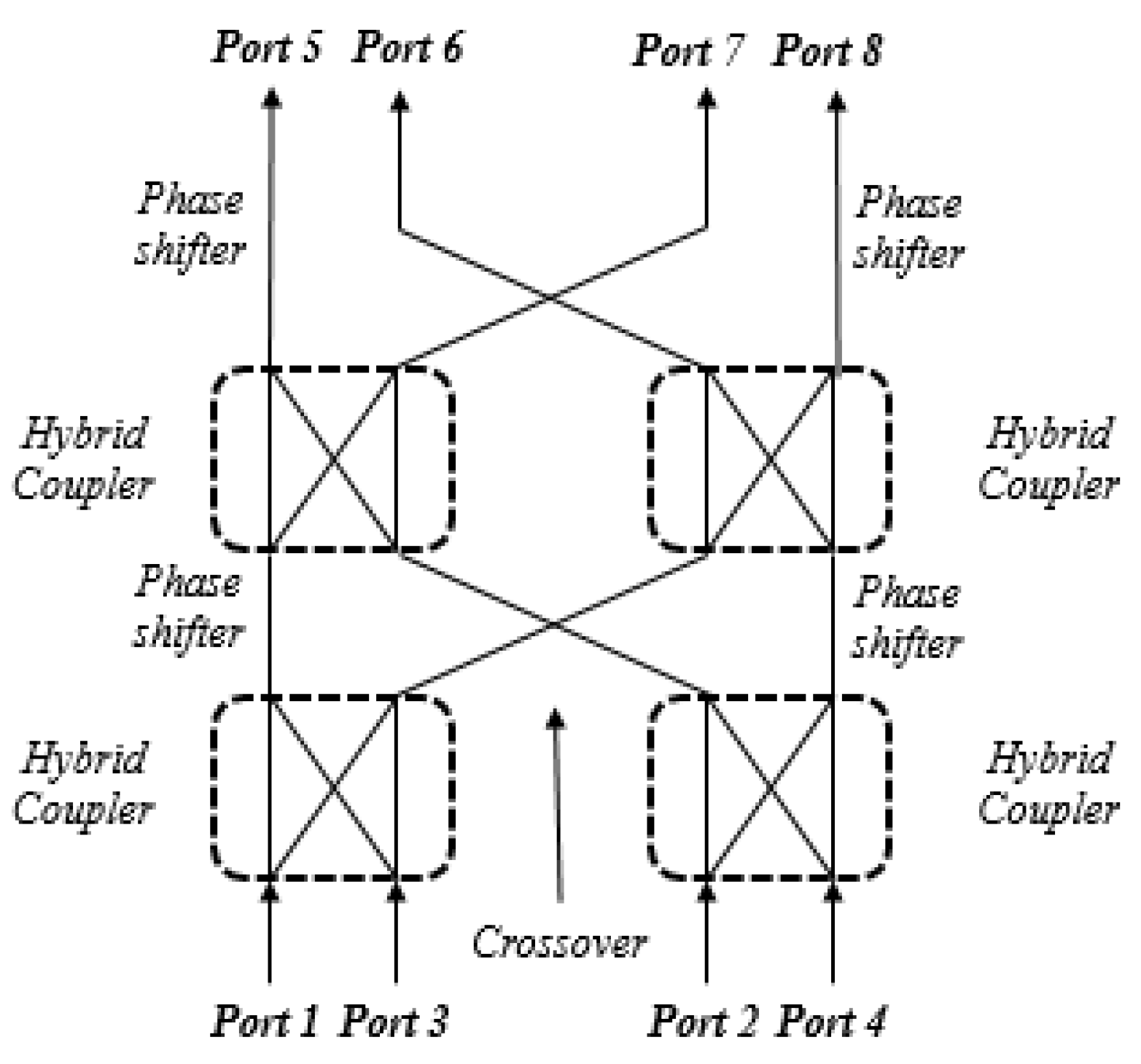
| Port 1 | Port 2 | Port 3 | Port 4 | |
|---|---|---|---|---|
| Port 5 | 90° | 135° | 90° | 135° |
| Port 6 | −135° | 90° | −135° | 0° |
| Port 7 | 0° | 45° | 0° | −135 |
| Port 8 | 135° | 0° | 135° | 90° |
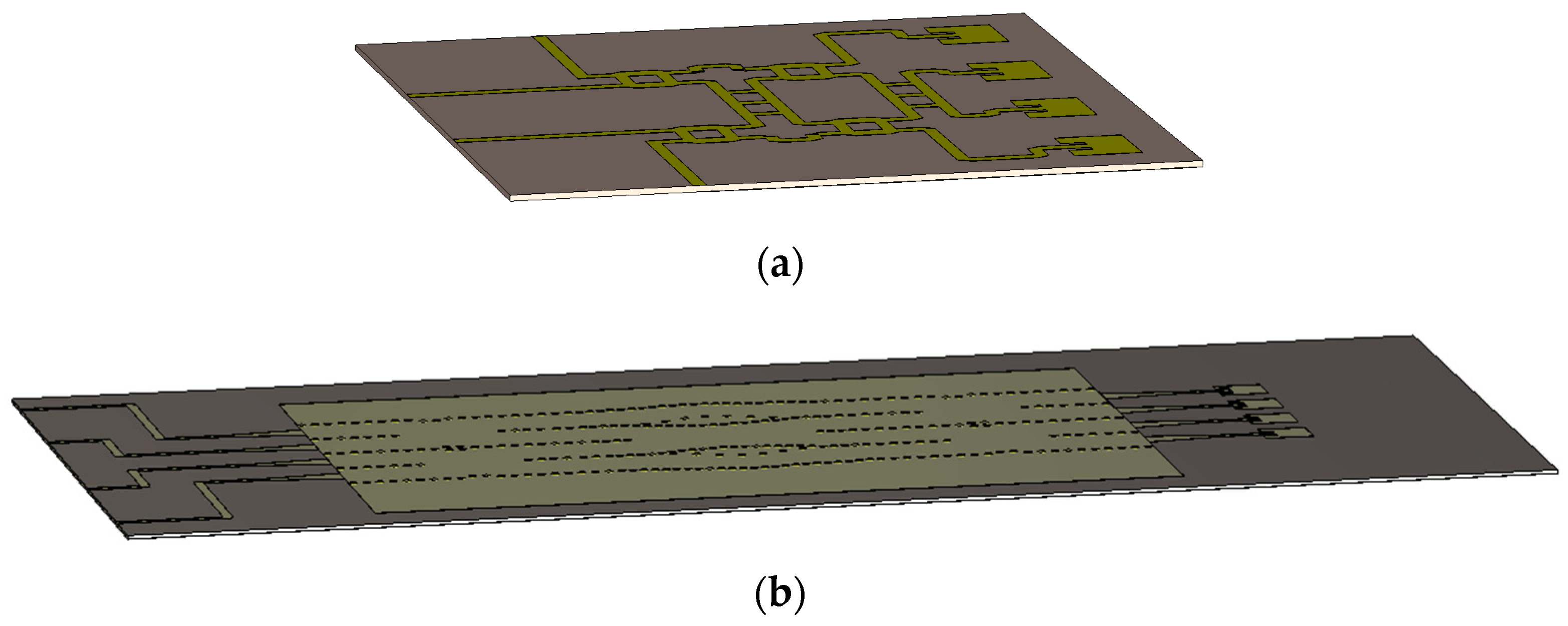
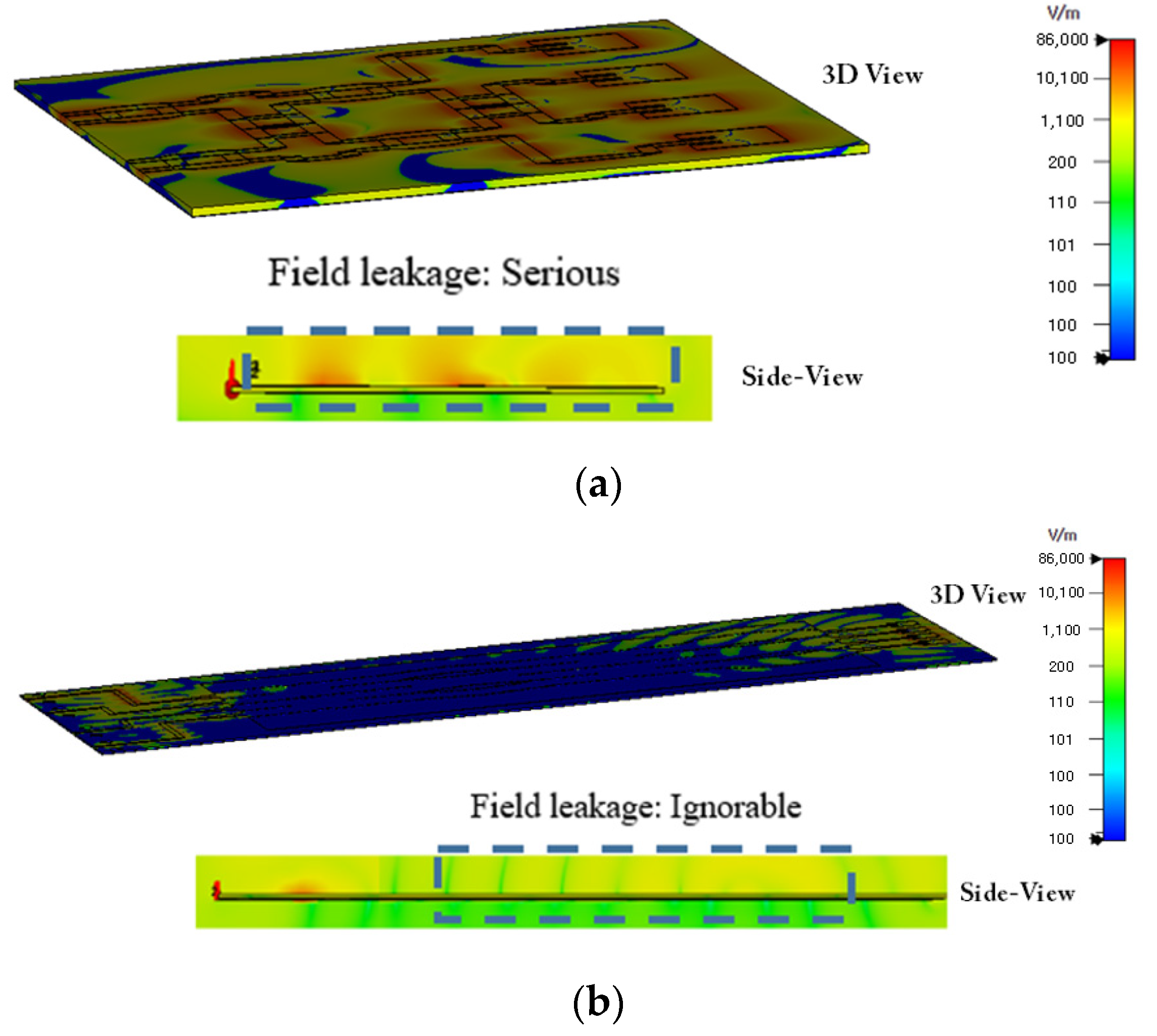
| Error | Port 1 | Port 2 | Port 3 | Port 4 |
|---|---|---|---|---|
| Microstrip-line | 8° | 0° | 1° | 8° |
| SIW | 3° | 0° | 1° | 1° |

| Direct RF-to-RF Link Test of the Tx and Rx Antennas S21 (Port-to-Port) of VNA (Component-Level Perspective) | Treating the Angles of the Tx and Rx Beams (Aligning the Tx and Rx Beams) (Component-Level Perspective) | Connectivity Test (Communication-System-Level Perspective) | Using the Chipset | Frequency (f > 6 GHz?) | Beamforming Antenna (Designed or Procured) | ||||
|---|---|---|---|---|---|---|---|---|---|
| QAM | Constellation | Active Phase Shifter | Active Power amp. | Remarks, If Any | |||||
| [22] | ⅹ | ⅹ | ⅹ | ⅹ | O | O | 15 GHz | Procured | |
| [23] | ⅹ | ⅹ | O (16-QAM) | O | O | O | Bi- CMOS | 28 GHz | Patch array (Designed) |
| [24] | ⅹ | ⅹ | O (64-QAM) | O | O | O | CMOS | 28 GHz | Yagi array (Designed) |
| [25] | ⅹ | ⅹ | O (256-QAM) | O | O | O | LTCC | 39 GHz | Procured |
| [26] | ⅹ | ⅹ | ⅹ | ⅹ | O | O | 28 GHz | Procured | |
| [27] | ⅹ | ⅹ | ⅹ | ⅹ | O | O | 28 GHz | Patch array (Designed) | |
| [28] | ⅹ | ⅹ | O (64-QAM) | O | O | O | MOSFET | 39 GHz | Patch array (Designed) |
| [29] | ⅹ | ⅹ | O (256-QAM | O | O | O | 2.4 GHz | Dipole array (Procured) | |
| [30] | ⅹ | ⅹ | O (64-QAM) | O | O | O | GaAs | 39 GHz | Yagi array (Designed) |
| [31] | ⅹ | ⅹ | O (64-QAM) | ⅹ | O | O | 3.5 GHz | Horn (Procured) | |
| This work | O | O | O (64-QAM) | O | ⅹ | ⅹ | 28 GHz | Patch array (Designed) | |
References
- Shafi, M.; Molisch, A.F.; Smith, P.J. 5G: A tutorial overview of standards, trials, challenges, deployment, and practice. IEEE J. Sel. Areas Commun. 2017, 35, 1201–1221. [Google Scholar] [CrossRef]
- Chen, Y. Challenges and opportunities of Internet of things. In Proceedings of the 17th Asia and South Pacific Design Automation Conference ASP-DAC, Sydney, Australia, 30 January–2 February 2012; pp. 383–388. [Google Scholar]
- Bleicher, A. The 5G phone future. IEEE Spectr. 2013, 50, 15–16. [Google Scholar] [CrossRef]
- Hong, W.; Baek, K.; Lee, Y. Study and prototyping of practically large-scale mm-wave antenna systems for 5G cellular devices. IEEE Commun. Mag. 2014, 52, 63–69. [Google Scholar] [CrossRef]
- Kim, Y.; Roh, W. Feasibility of mobile cellular communications at millimeter wave frequency. IEEE J. Sel. Top. Signal Process. 2016, 10, 589–599. [Google Scholar] [CrossRef]
- Roh, W.; Seol, J.-Y.; Park, J. Millimeter-wave beamforming as an enabling technology for 5G cellular communications: Theoretical feasibility and prototype results. IEEE Commun. Mag. 2014, 52, 106–113. [Google Scholar] [CrossRef]
- Cheng, Y.-J. Substrate Integrated Antennas and Arrays; CRC Press Taylor & Francis Group: Boca Raton, FL, USA, 2016. [Google Scholar]
- Cassivi, Y.; Perregrini, L.; Arcioni, P. Dispersion characteristics of substrate integrated rectangular waveguide. IEEE Microw. Wirel. Compon. Lett. 2002, 12, 333–335. [Google Scholar] [CrossRef]
- Liu, D. Advanced Millimeter-Wave Technologies: Antennas, Packaging and Circuits; Wiley: New York, NY, USA, 2009. [Google Scholar]
- He, F.; Wu, K.; Hong, W. Low-cost 60 GHz smart antenna receiver subsystem based on substrate integrated waveguide technology. IEEE Trans. Microw. Theory Tech. 2012, 60, 1156–1165. [Google Scholar] [CrossRef]
- Yamamoto, S.; Hirokawa, J.; Ando, M. A beam switching slot array with a 4-way Butler matrix installed in a single layer post-wall waveguide. EICE Trans. Commun. 2008, 86, 1653–1659. [Google Scholar]
- Ojaroudiparchin, N.; Shen, M.; Pedersen, G.F. Multi-layer 5G mobile phone antenna for multi-user MIMO communications. In Proceedings of the 2015 23rd Telecommunications Forum Telfor, Belgrade, Serbia, 24–26 November 2015. [Google Scholar]
- Park, J.H.; Lee, S.Y.; Kim, Y.W.; Lee, J.Y.; Hong, W.B. Hybrid Antenna Module Concept for 28 GHz 5G Beamsteering Cellular Devices. In Proceedings of the 2018 IEEE MTT-S International Microwave Workshop Series on 5G Hardware and System Technologies, Dublin, Ireland, 30–31 August 2018. [Google Scholar]
- Chen, S.; Zhao, A. Wideband 28 GHz ground reflected dipole antenna and array for 5G mobile handset. In Proceedings of the 2018 IEEE International Symposium on Antennas and Propagation & USNC/URSI National Radio Science Meeting, Boston, MA, USA, 8–13 July 2018. [Google Scholar]
- Paola, C.D.; Zhang, S.; Zhao, K.; Ying, Z.; Bolin, T.; Pedersen, G.F. Wideband Beam-Switchable 28 GHz Quasi-Yagi Array for Mobile Devices. IEEE Trans. Antennas Propagat. 2019, 67, 6870–6882. [Google Scholar] [CrossRef]
- Rappaport, T.S.; Roh, W.; Cheun, K. Smart Antennas Could Open up New Spectrum For 5G: Future cellular networks could exploit the huge bandwidths available in millimeter-wave spectrum. IEEE Spectr. 2014, 51, 35–38. [Google Scholar]
- Lee, C.; Khattak, M.K.; Kahng, S. Wideband 5G beamforming Printed Array Clutched by LTE-A 4 × 4-Multiple-Input–Multiple-Output Antennas with High Isolation. IET Microw. Antennas Propag. 2018, 12, 1407–1413. [Google Scholar] [CrossRef]
- Li, W.-Y.; Chung, W.; Chou, J.-H. Highly-Integrated Wideband 28 GHz and 39 GHz Array Antennas for 5G Mobile Phone Applications. In Proceedings of the 2020 IEEE International Symposium on Antennas and Propagation and North American Radio Science Meeting, Montreal, QC, Canada, 5–10 July 2020. [Google Scholar]
- Lee, C.; Park, H.; Lim, Y.; Kahng, S. A stacked array antenna able to make a very large gain and tilt the end-fire beam at the ISM-band. Int. J. RF Microw. Comput.-Aided Eng. 2019, 29, e21821. [Google Scholar] [CrossRef]
- Stutzman, W.L.; Thiele, G.A. Antenna Theory and Design, 3rd ed.; John Wiley & Son: Hoboken, NJ, USA, 2012; ISBN 978-0-470-57664-9. [Google Scholar]
- Vallappil, A.K.; Rahim, M.K.A.; Khawaja, B.A.; Murad, N.A.; Mustapha, M.G. Butler Matrix Based Beamforming Networks for Phased Array Antenna Systems: A Comprehensive Review and Future Directions for 5G Applications. IEEE Access 2021, 9, 3970–3987. [Google Scholar] [CrossRef]
- Simonsson, A. Beamforming Gain Measured on a 5G Test-Bed. In Proceedings of the 2017 IEEE 85th Vehicular Technology Conference, Sydney, NSW, Australia, 4–7 June 2017. [Google Scholar]
- Kibaroglu, K.; Sayginer, M.; Rebeiz, G.M. An ultra low-cost 32-element 28 GHz phased-array transceiver with 41 dBm EIRP and 1.0–1.6 Gbps 16-QAM link at 300 meters. In Proceedings of the 2017 IEEE Radio Frequency Integrated Circuits Symposium, Honolulu, HI, USA, 4–6 June 2017; pp. 73–76. [Google Scholar] [CrossRef]
- Kim, H. A 28-GHz CMOS Direct Conversion Transceiver with Antenna Array for 5G Cellular System. IEEE J. Solid-State Circuits 2018, 53, 1245–1259. [Google Scholar] [CrossRef]
- Chen, Z. A 256-QAM 39 GHz Dual-Channel Transceiver Chipset with LTCC Package for 5G Communication in 65 nm CMOS. In Proceedings of the 2018 IEEE/MTT-S International Microwave Symposium, Philadelphia, PA, USA, 10–15 June 2018; pp. 1476–1479. [Google Scholar] [CrossRef]
- Ng, E.; Ayed, A.B.; Mitran, P.; Boumaiza, S. Single-Input Single-Output Digital Predistortion of Multi-user RF Beamforming Arrays. In Proceedings of the 2019 IEEE MTT-S International Microwave Symposium, Boston, MA, USA, 2–7 June 2019. [Google Scholar]
- Pei, H.; Chen, X.; Zhang, M.; Zhang, A. Over-the-Air Testing of 5G Millimeter-Wave System with Adaptive Beamforming. In Proceedings of the 2019 IEEE MTT-S International Wireless Symposium, Guangzhou, China, 19–22 May 2019. [Google Scholar]
- Roy, A.G. A 37–40 GHz Phased Array Front-end with Dual Polarization for 5G MIMO Beamforming Applications. In Proceedings of the 2019 IEEE Radio Frequency Integrated Circuits Symposium, Boston, MA, USA, 2–4 June 2019. [Google Scholar]
- Golabighezelahmad, S.; Klumperink, E.; Nauta, B. EVM-based Performance Evaluation of Co-channel Interference Mitigation using Spatial Filtering for Digital MIMO Receivers. In Proceedings of the 2020 IEEE 92nd Vehicular Technology Conference (VTC2020-Fall), Victoria, BC, Canada, 18 November–16 December 2020. [Google Scholar]
- Chen, C.-N. 38-GHz Phased Array Transmitter and Receiver Based on Scalable Phased Array Modules With Endfire Antenna Arrays for 5G MMW Data Links. IEEE Trans. Microw. Theory Tech. 2021, 69, 980–999. [Google Scholar] [CrossRef]
- Adegoke, E.; Kampert, E.; Higgins, M.D. Channel Modeling and Over-the-Air Signal Quality at 3.5 GHz for 5G New Radio. IEEE Access 2021, 9, 11183–11193. [Google Scholar] [CrossRef]
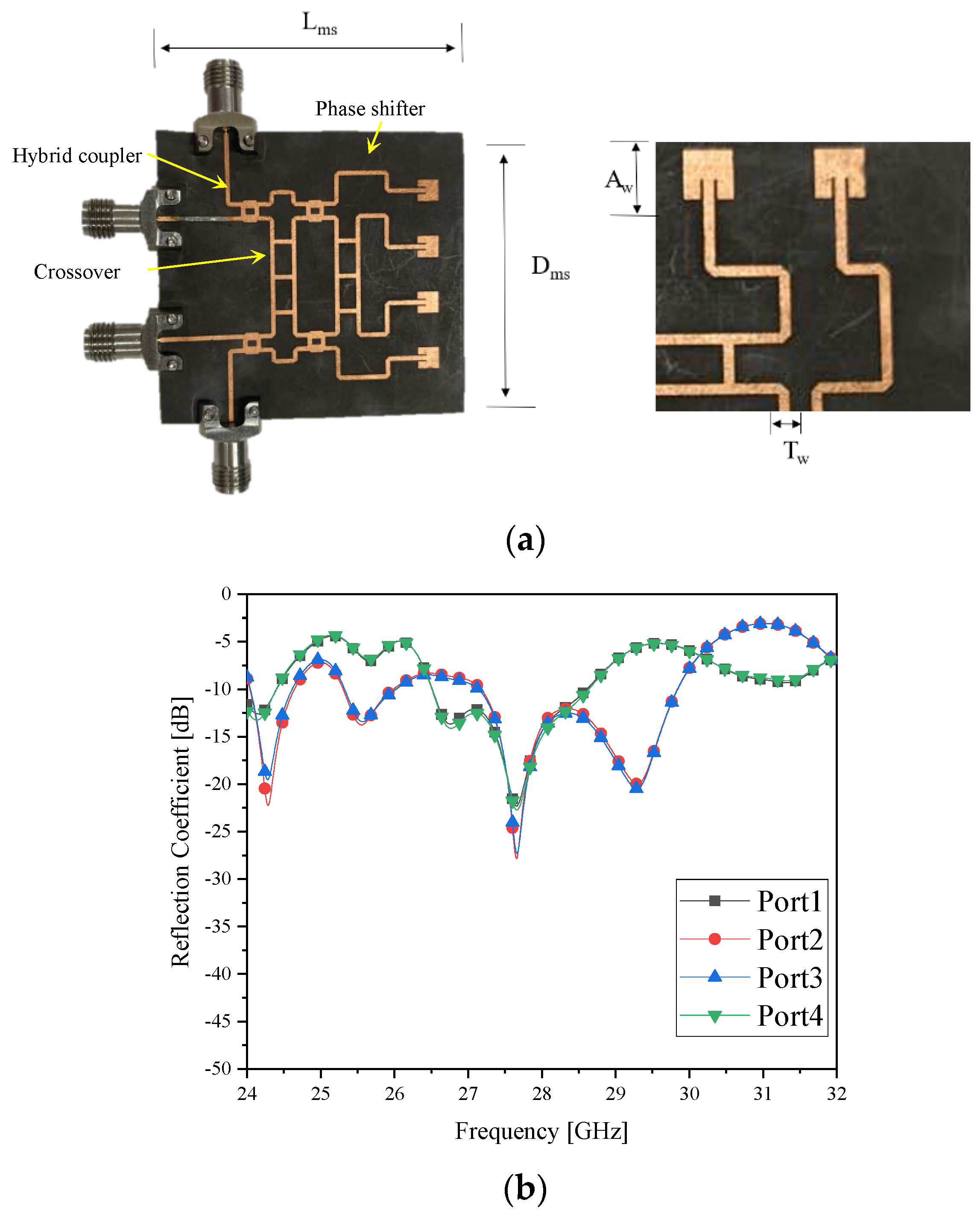









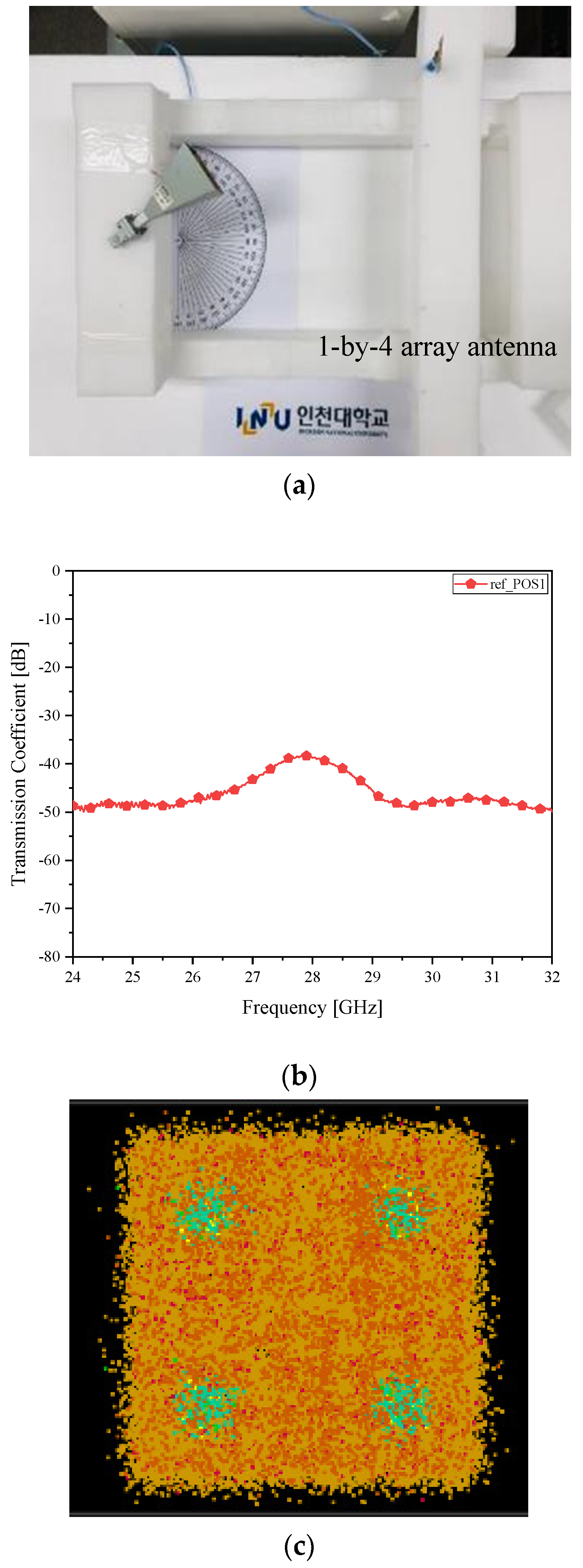



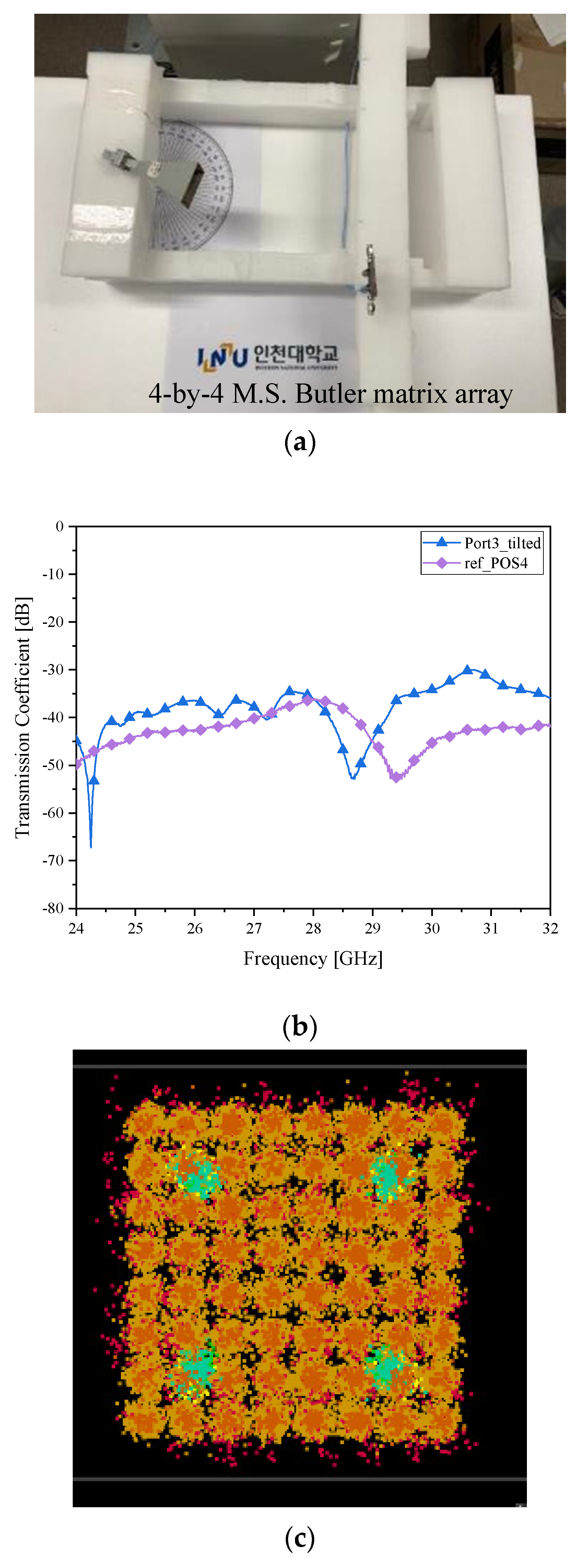



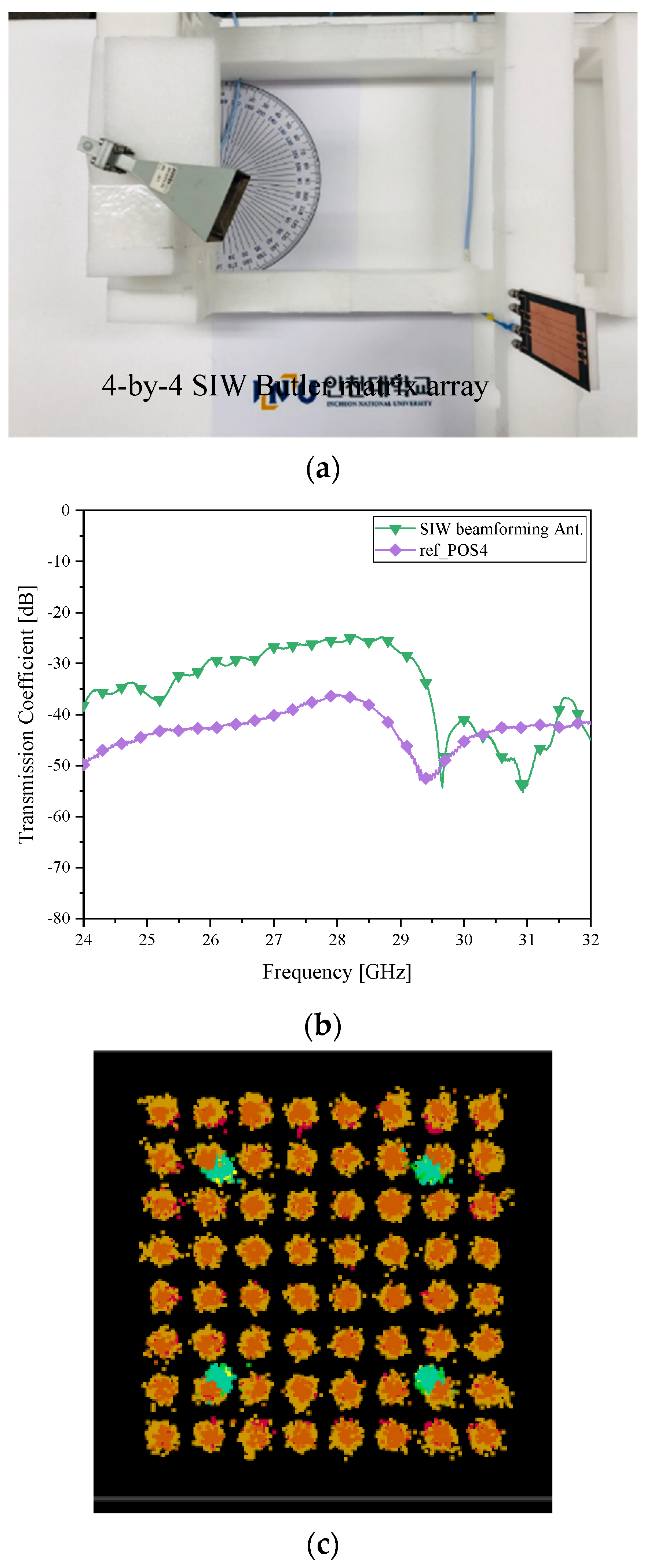
| Parameter | Value |
|---|---|
| Lms | 49 mm |
| Dms | 51.92 mm |
| Aw | 3.48 mm |
| Tw | 0.7 mm |
| Antenna gap | 8.1 mm |
| Variable Name | Value |
|---|---|
| Lsiw | 119.26 mm |
| Dsiw | 56.9 mm |
| Aw | 3.53 mm |
| Tw | 5.8 mm |
| Antenna gap | 5.6 mm |
Publisher’s Note: MDPI stays neutral with regard to jurisdictional claims in published maps and institutional affiliations. |
© 2021 by the authors. Licensee MDPI, Basel, Switzerland. This article is an open access article distributed under the terms and conditions of the Creative Commons Attribution (CC BY) license (https://creativecommons.org/licenses/by/4.0/).
Share and Cite
Jeon, M.; Seo, Y.; Cho, J.; Lee, C.; Jang, J.; Lee, Y.; Kwon, H.-W.; Kahng, S. Investigation on Beam Alignment of a Microstrip-Line Butler Matrix and an SIW Butler Matrix for 5G Beamforming Antennas through RF-to-RF Wireless Sensing and 64-QAM Tests. Sensors 2021, 21, 6830. https://doi.org/10.3390/s21206830
Jeon M, Seo Y, Cho J, Lee C, Jang J, Lee Y, Kwon H-W, Kahng S. Investigation on Beam Alignment of a Microstrip-Line Butler Matrix and an SIW Butler Matrix for 5G Beamforming Antennas through RF-to-RF Wireless Sensing and 64-QAM Tests. Sensors. 2021; 21(20):6830. https://doi.org/10.3390/s21206830
Chicago/Turabian StyleJeon, Munsu, Yejune Seo, Junghyun Cho, Changhyeong Lee, Jiyeon Jang, Yejin Lee, Hyung-Wook Kwon, and Sungtek Kahng. 2021. "Investigation on Beam Alignment of a Microstrip-Line Butler Matrix and an SIW Butler Matrix for 5G Beamforming Antennas through RF-to-RF Wireless Sensing and 64-QAM Tests" Sensors 21, no. 20: 6830. https://doi.org/10.3390/s21206830
APA StyleJeon, M., Seo, Y., Cho, J., Lee, C., Jang, J., Lee, Y., Kwon, H.-W., & Kahng, S. (2021). Investigation on Beam Alignment of a Microstrip-Line Butler Matrix and an SIW Butler Matrix for 5G Beamforming Antennas through RF-to-RF Wireless Sensing and 64-QAM Tests. Sensors, 21(20), 6830. https://doi.org/10.3390/s21206830






